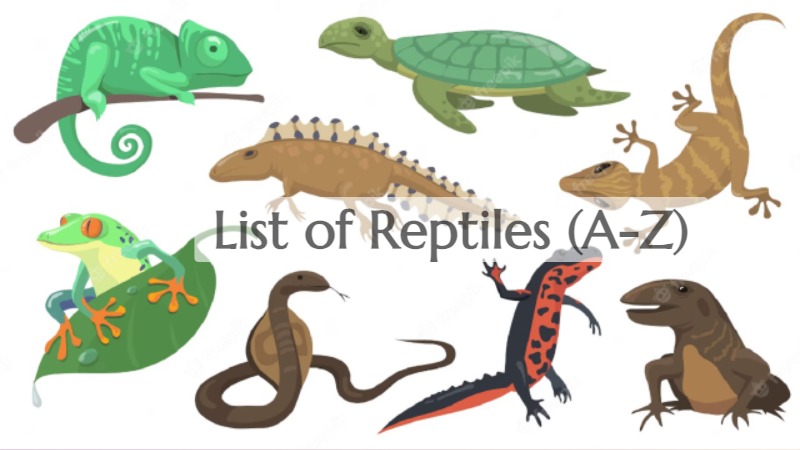
Reptiles list (a-z) including snakes, lizards, turtles, crocodilians, amphisbaenians, tuatara and their extinct relatives available, check names of reptiles in alphabetical order. Reptiles are tetrapod animals in the class Reptilia. The study of these traditional reptile orders, historically combined with that of modern amphibians, is called herpetology.
The following list of reptiles lists the vertebrate class of reptiles by family, spanning two subclasses. Reptile here is taken in its traditional (paraphyletic) sense, and thus birds are not included (although birds are considered reptiles in the cladistic sense).
Reptiles List (A-Z)
- African burrowing asps
- Afro-American sideneck turtle
- Agamas (Agamidae)
- Alligator
- Alligator snapping turtle
- American legless lizard
- American sideneck river turtle
- Anaconda
- Anoles
- Asian river turtle
- Asian pipe snake
- Austro-American sideneck turtle
- Ball pythons
- Basilisks (also known as Jesus Christ lizards)
- Bearded Dragon
- Blind lizard
- Blind snake
- Boa
- Boa constrictors
- Box turtle
- Caimans (Alligatoridae)
- Casquehead lizard
- Chameleon
- Cobra
- Collared lizards or Crotaphytidae
- Colubrids or typical snake
- Common snapping turtle
- Constrictor (Boidae)
- Coral snake
- Corn snakes
- Crocodile
- Crocodilians (Crocodylia)
- Cryptodiras (Testudines)
- Desert Tortoise
- Dwarf boa
- Dwarf pipe snake
- Earless monitor lizard
- Fae’s viper
- False coral snake
- Flying lizard
- Freshwater turtles
- Gecko
- Gharial
- Gila monster
- Glass lizard
- Gray
- Green Iguana
- Horned lizard
- Hylonomus
- Iguanas
- King Snakes
- Knob scaled lizard
- Komodo dragon
- Lacertid
- Leatherback turtle
- Legless lizard
- Leopard lizard
- Lizards
- Madagascan big-headed turtle
- Madagascar iguanid
- Mamba
- Mauritius snake
- Mexican python
- Monitor lizard
- Mud turtle
- Neotropical ground lizard
- Night adder
- Night lizard
- Old World sand boas
- Pignose turtle
- Pipe snake
- Pitvipers
- Plastron
- Plated lizard
- Pleurodira
- Pond turtle
- Primitive blind snake
- Python
- Rattlesnake
- River turtle
- Sand boas
- Sea snake
- Sea turtle
- Shieldtail snake
- Shorthead worm lizard
- Skink
- Slender blind snake
- Snakes
- Softshell turtle
- Spectacled lizard
- Spinytail lizard
- Spiny-tailed iguanas
- Stiletto snake
- Sunbeam snake
- Tegu
- Thread snake
- Tortoises
- True viper
- Tuatara
- Turtles
- Two-legged worm lizards
- Typical blind snake
- Venom
- Viper
- Wall lizard
- Wart lizard
- Whiptail lizard (racerunners)
- Wood lizard
- Worm lizard
Please note that this list is not exhaustive, as there are numerous species of reptiles in the world.
What are Reptiles
Reptiles are a diverse group of vertebrate animals characterized by several key features:-
- Cold-blooded: Reptiles are ectothermic, which means their body temperature is determined by the external environment. They cannot regulate their body temperature internally like warm-blooded mammals.
- Scales: Reptiles have dry and scaly skin, which helps protect them from water loss and provides a barrier against pathogens. The scales can vary in size, shape, and texture depending on the species.
- Terrestrial or Aquatic: Reptiles inhabit a range of habitats, including deserts, forests, grasslands, and aquatic environments. While some reptiles are adapted to live in water, such as turtles and crocodiles, many reptile species are adapted for life on land. They have limbs (except for snakes) and are generally well-suited for moving on land.
- Carnivorous Diet: Most reptiles are carnivores, feeding on a variety of prey including insects, small mammals, birds, and other reptiles. However, some reptiles, like tortoises and iguanas, are herbivorous and primarily consume plants.
- Lung Respiration: Reptiles breathe air through lungs. They have well-developed lungs that enable efficient gas exchange.
- Amniotic Eggs: Most reptiles lay amniotic eggs with a protective shell. These eggs have an amniotic membrane that surrounds and protects the developing embryo, allowing reptiles to reproduce on land.










